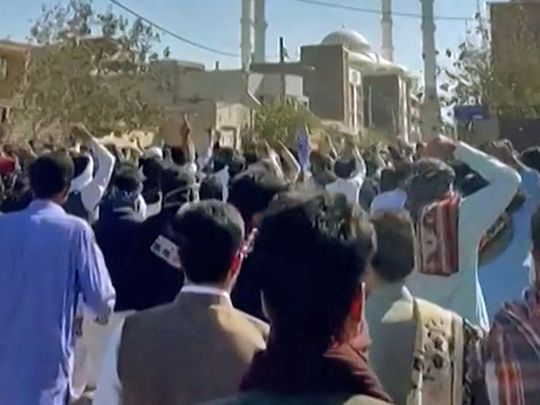
Tehran: Iran’s Supreme Leader Ayatollah Ali Khamenei said on Friday that noone should dare think they can uproot the Islamic Republic, in his toughest warning to protesters since Mahsa Amini’s death in police custody ignited nationwide unrest now in its fourth week.
Demonstrations by people from all walks of life over the Iranian Kurdish woman’s case have evolved into widespread calls for the downfall of Khamenei and for “Death to the Islamic Republic”.
The protests mark one of the boldest challenges to clerical rule since the 1979 revolution, even if the unrest does not seem close to toppling the system.
Khamenei compared the Islamic Republic to an unshakeable tree. “That seedling is a mighty tree now and noone should dare think they can uproot it,” he said in remarks shown on state TV.
Police deployed heavily on Friday in a predominantly ethnic Arab city after activists called for protests, a witness said, as the unrest showed no sign of abating.
Some of the deadliest unrest has been in areas home to ethnic minorities with long-standing grievances against the state, including Kurds in the northwest and Baluchis in the southeast.
Rights groups say more than 200 people have been killed in the crackdown, including teenage girls.
Amnesty International said at least 23 children have been killed by security forces in Iran during the protests. The victims, aged between 11 and 17, include 20 boys and 3 girls.
Amini died on September 16 after being arrested in Tehran by Iran’s morality police for “inappropriate attire”.
Police also deployed heavily on Friday in the city of Dezful, a witness said, after activists called for protests in the predominantly Arab, oil-rich province of Khuzestan at the Iraqi border.
There was heavy deployment too of police and the Basij - a volunteer militia leading the crackdown - in the main squares of Zahedan, the capital of Sistan-Baluchistan province at the border with Pakistan in the southeast, two witnesses said.
Iran has blamed the violence on enemies at home and abroad, including armed separatists and Western powers, accusing them of conspiring against the Islamic Republic and denying security forces have killed protesters. State TV reported at least 26 members of the security forces have been killed.
DEATHS MOUNT
Zahedan was the scene of one of the deadliest days yet on September 30 when Amnesty International has said security forces killed at least 66 people in a crackdown after prayers.
The authorities said Baluchi militants attacked a police station that day, triggering a shootout. The Revolutionary Guards said five members of its forces and the volunteer Basij militia were killed.
Iran, with a population of 87 million, is home to seven ethnic minorities alongside majority Persians. Rights groups say minorities, including Kurds and Arabs, have long faced discrimination. Iran denies this.
A revolutionary Guards major and a Basij militiaman were shot dead by “rioters” early on Friday in southern Fars province, state TV reported. A news agency said the two were shot after confronting “two rioters” writing graffiti.
Security forces have also pressed their crackdown this week in Kurdish regions where the Revolutionary Guards have a track record of putting down dissent.
Iran’s Kurds are part of an ethnic minority spread between several regional states whose autonomy aspirations have also led to conflicts with authorities in Iraq, Syria and Turkey.
Along the Iranian-Iraqi border in southwest Iran is a population of some three million ethnic Arabs, predominantly Shiite. Some groups, emboldened by Iraqi Arabs across the border, have pressed for greater autonomy in recent years.
While many officials have struck an uncompromising tone, a top adviser to Khamenei was cited this week as questioning whether police should be enforcing headscarf-wearing - rare criticism of state efforts to impose the hijab.
Amini’s death and the crackdown have drawn condemnation from the United States and other Western powers, prompting new sanctions on Iranian officials and adding to tensions at a time when talks to revive the 2015 nuclear deal are at a standstill.












